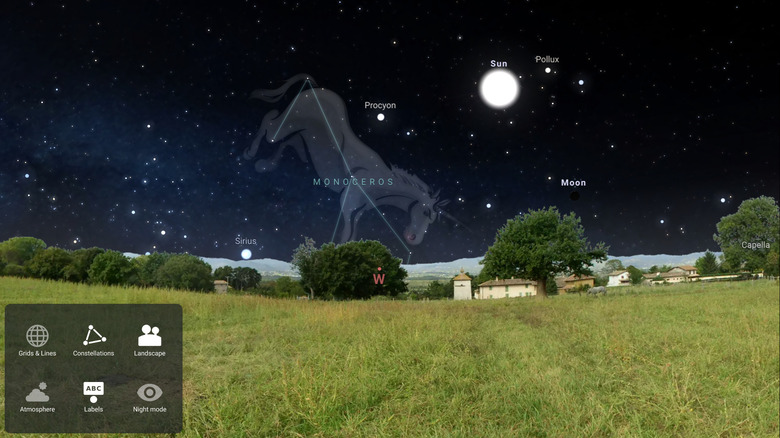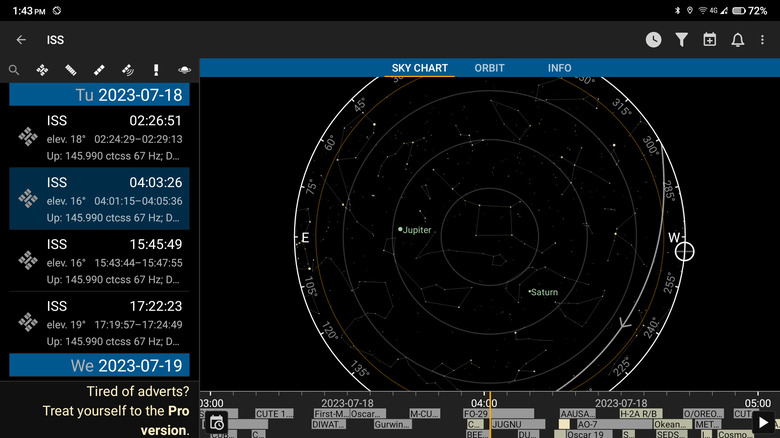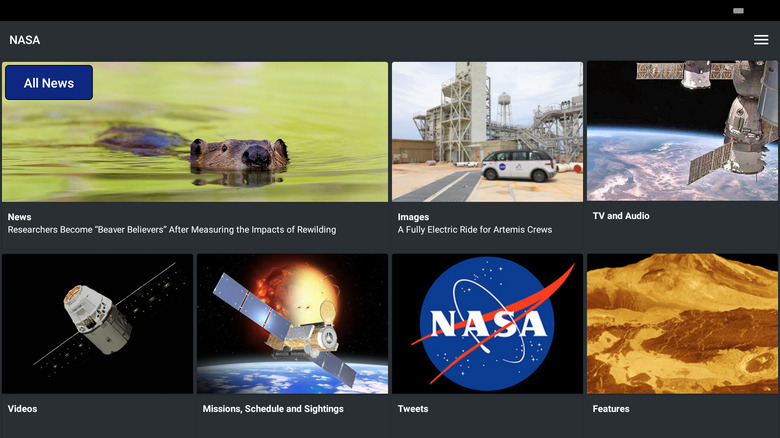The 5 Best Android Apps For Astronomy
If there's one fun thing you can do at night aside from making smores by the campfire, it's gazing at the stars. There's just something relaxing about being under twinkling balls of light and watching meteors and blinking man-made satellites pass you by. But while stargazing with no equipment and just a mere blanket is already a treat in itself, why not elevate the experience with astronomy apps?
Most astronomy apps enhance your stargazing activity by helping you identify the names of the celestial objects you're seeing. Some apps can also tell you the best times to observe certain planets, where to expect them, and whether you can see them with just your naked eye. If you're on an Android device, there are multiple such astronomy apps on the Google Play Store for your choosing. To make it convenient for you, we've compiled five of the best ones in this list.
Star Walk 2
Star Walk 2 shows you the positions of various astronomical objects from your chosen location. It features constellations, solar system objects (planets, moon, meteor showers, asteroids, comets), deep sky objects (e.g., Owl Nebula, Minkowski's Butterfly, Hercules Globular Cluster), and even satellites (e.g., SpaceX's Starlink satellites, the International Space Station, and NASA's Interstellar Boundary Explorer). It tells you each object's rising and setting times to help you plan your stargazing activity. There's also a separate "Visible Tonight" tab, where you can see the major objects visible on a particular day. This will tell you more about the optimal viewing times for the objects.
By default, Star Walk 2 uses your device's current time and location. However, you have the option to change the time to a past or future date to see what the sky looks like during that period. You can also change the location by manually setting the coordinates or choosing from the predefined list of cities. Another highlight of the app is its augmented reality feature that lets you use your camera to point to a space in the night sky. The app will then determine what celestial objects you can see on your screen. If you upgrade to the premium version, you'll have access to more information and photos of these objects.
One downside of Star Walk 2 is that users report frequent app crashes. And if you don't pay for premium, you've to put up with ads that are quite intrusive and annoying.
Stellarium Mobile
Featuring an expansive collection of celestial objects, Stellarium Mobile is one of the best Android apps for astronomy. It has information on more than 1.4 billion stars, 3 million galaxies and nebulae, 10,000 asteroids, and even the majority of visible man-made satellites. One of the main draws of the app is its minimalist and intuitive interface. Buttons don't crowd the screen, making it a lot more enjoyable to view the night sky in all its glory. There's also a Night Mode feature that you can enable to turn your phone screen red for easier use in the dark.
Stellarium Mobile uses your device's sensors, so whenever you point to a particular spot, you'll see the relevant celestial objects on your phone screen. You can then tap on the object of your choice and zoom in to view it better. Naturally, you'll get information on said object. If you frequently check on an object, you can save it to your favorites for easier access. What sets the app apart from other astronomy apps is that you can view the sky using different sky cultures. Aside from the widely used and accepted Western one, there are more options, such as Chinese, Inuit, and Norse.
You can use Stellarium Mobile for free. But if you want to control a telescope, view objects in 3D, and have access to the built-in astronomical calendar, you'll need to upgrade to a paid account.
Nightshift Stargazing
If you're looking for an easier way to plan your stargazing activity, then you might want to check out Nightshift Stargazing. The app provides all the information you'll need to make the most out of your night. It tells you the weather condition (both current and forecast) in your area, including cloud cover and precipitation.
You can also look at the astronomical highlights for a particular night. This will give you valuable insights, such as when the sun and moon will rise and set, what phase the moon will be in, how long it will be dark outside, which planets will be visible, what time you can observe each visible planet, and whether there will be any active meteor showers.
If the app indicates that a specific night is excellent for stargazing, it will also provide a complete list of the best celestial objects for observation, the times you can see them, and with what equipment (e.g., naked eye, binoculars, telescope). If, however, the app indicates no stargazing opportunities, you can opt to receive a notification once conditions change.
If you're looking to observe one of the other seven solar system planets or one of the 15,000 deep-sky objects (DSO) in the app's database, you can also easily do so. Nightshift Stargazing will tell you the days and times you can see your object of interest, its rising and setting times, and the best equipment for viewing.
Heavens-Above
Primarily focused on tracking visible and radio satellites, Heavens-Above is the go-to astronomy app if you're more into observing man-made objects than planets and stars. The app features three primary tabs on the dashboard: the Sky Chart, Orbit, and Info.
As the name suggests, Sky Chart is a chart of the sky above you. It shows you the names of the planets and constellations you can potentially see when you look up. If you choose a satellite from the sidebar, its track will also appear on the Sky Chart. To figure out the exact position of the planets and satellites, orient your mobile device toward the sky, and a pointer on the Sky Chart will move accordingly. Keep moving the pointer to where your object of interest is to help you determine its location in real life.
The Orbit tab displays a map of the Earth (with your current location pinpointed) and the track of a particular satellite. Lastly, the Info tab provides more data about your satellite of choice, including its uplink and downlink, orbit details, intrinsic brightness, and launch information. Another great thing about Heavens-Above is that you can readily add the satellite pass as an event on your calendar. This helps remind you of the date and time your favorite satellite would pass over you.
You can use the app for free, but you'll have to buy the pro version to remove the ads.
NASA
NASA isn't the typical astronomy app that shows you a view of the night sky as soon as you open it. Instead, it features all things NASA, from official photos, videos, stories, news, and other relevant content.
You can find seven categories in this 100% free app. There's the News section, containing the latest news and features from the governmental space body, and the Tweets section, housing the agency's tweets. You have the Missions, Schedule, and Sightings section that provides up-to-date information about NASA's upcoming and ongoing programs and missions. This section's highlight is the ISS tab, which includes a Map feature that lets you track the station and see upcoming sightings in your location.
The TV and Audio section lets you watch live NASA TV and live-streamed video from the ISS and listen to NASA's podcast, NASAcast. If you're looking for higher quality videos, head to the Videos section, where you can find more than 14,000 videos, including 4K and 360-degree videos of space objects, mission control rooms, and NASA experts discussing space-related educational content.
Aside from videos, there are lots of photos in the app, too. In the Images section, you'll see a wealth of photographic content that's updated daily, from celestial objects to NASA equipment and scientists. Finally, you have the Features section, displaying in-depth information on celestial objects with 2D photos and interactive maps of their location in space.





